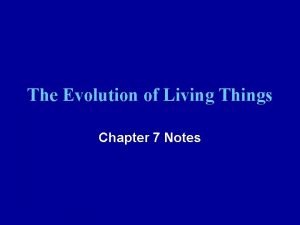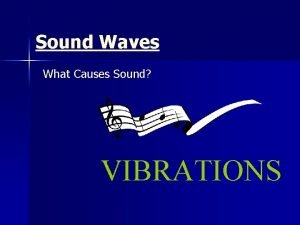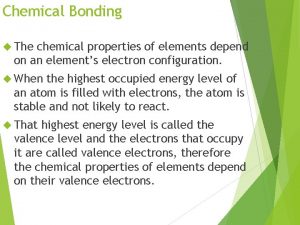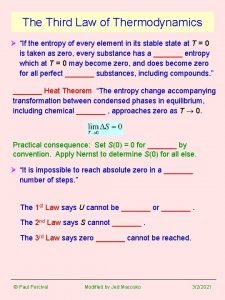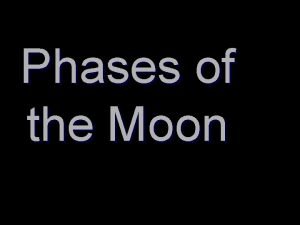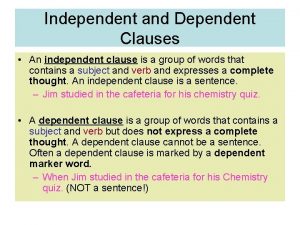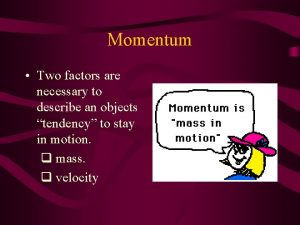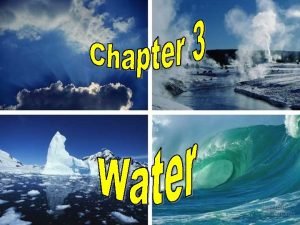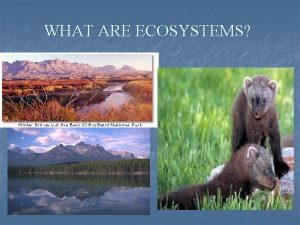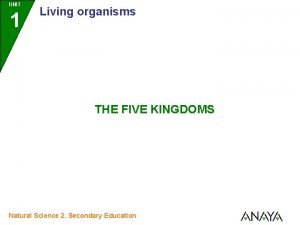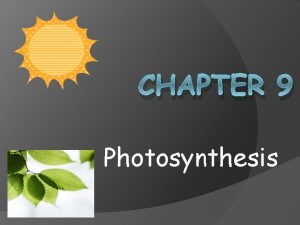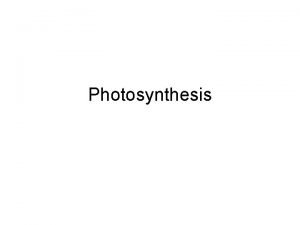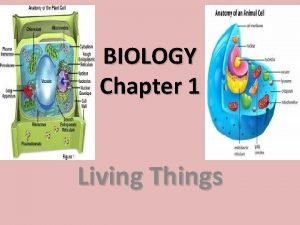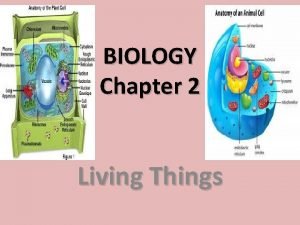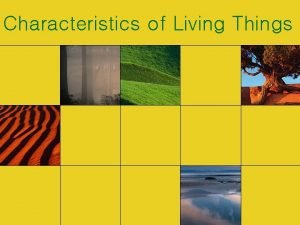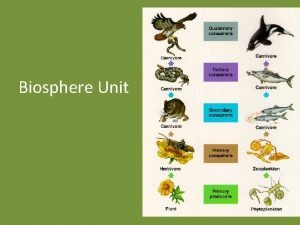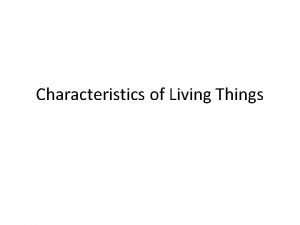Photosynthesis Chapter 13 Photosynthesis Most living things depend
































- Slides: 32

Photosynthesis Chapter 13

Photosynthesis • Most living things depend on photosynthetic cells to manufacture the complex organic molecules they require as a source of energy. • Photosynthetic cells are quite diverse and include cells found in green plants, phytoplankton, and cyanobacteria.

Photosynthesis • During the process of photosynthesis, cells use carbon dioxide and energy from the Sun to make sugar molecules and oxygen. • These sugar molecules are the basis for more complex molecules made by the photosynthetic cell, such as glucose. • Then, via respiration processes, cells use oxygen and glucose to synthesize energy-rich carrier molecules, such as ATP, and carbon dioxide is produced as a waste product.

Photosynthesis • The building and breaking of carbon-based material — from carbon dioxide to complex organic molecules (photosynthesis) then back to carbon dioxide (respiration) — is part of what is commonly called the global carbon cycle • Indeed, the fossil fuels we use to power our world today are the ancient remains of once-living organisms, and they provide a dramatic example of this cycle at work. • The carbon cycle would not be possible without photosynthesis, because this process accounts for the "building" portion of the cycle


Photosynthesis • Chlorophyll, the primary pigment used in photosynthesis, reflects green light and absorbs red and blue light most strongly. In plants, photosynthesis takes place in chloroplasts, which contain the chlorophyll. • Chloroplasts are surrounded by a double membrane and contain a third inner membrane, called the thylakoid membrane, that forms long folds within the organelle.



What Are the Steps of Photosynthesis? • Photosynthesis consists of both light-dependent reactions and light-independent reactions. • In plants, the so-called "light" reactions occur within the chloroplast thylakoids, where the aforementioned chlorophyll pigments reside. • When light energy reaches the pigment molecules, it energizes the electrons within them, and these electrons are shunted to an electron transport chain in the thylakoid membrane.


Photosynthesis • Every step in the electron transport chain then brings each electron to a lower energy state and harnesses its energy by producing ATP and NADPH. • Meanwhile, each chlorophyll molecule replaces its lost electron with an electron from water; this process essentially splits water molecules to produce oxygen


Light independent reactions • Once the light reactions have occurred, the lightindependent or "dark" reactions take place in the chloroplast stroma. • During this process, also known as carbon fixation, energy from the ATP and NADPH molecules generated by the light reactions drives a chemical pathway that uses the carbon in carbon dioxide (from the atmosphere) to build a three-carbon sugar called glyceraldehyde-3 phosphate (G 3 P).

Light independent reactions • Cells then use G 3 P to build a wide variety of other sugars (such as glucose) and organic molecules. • Many of these interconversions occur outside the chloroplast, following the transport of G 3 P from the stroma. • The products of these reactions are then transported to other parts of the cell, including the mitochondria, where they are broken down to make more energy carrier molecules to satisfy the metabolic demands of the cell.

Light independent reactions • The Calvin cycle has four main steps: carbon fixation, reduction phase, carbohydrate formation, and regeneration phase. • Energy to fuel chemical reactions in this sugargenerating process is provided by ATP and NADPH, chemical compounds which contain the energy plants have captured from sunlight.


Photorespiration • Photorespiration refers to a process in plant metabolism where the enzyme Ru. Bis. CO oxygenates Ru. BP, causing some of the energy produced by photosynthesis to be wasted. • Photorespiration is a biochemical process in plants in which, especially under conditions of water stress, oxygen inhibits the Calvin cycle, the carbon fixation portion of photosynthesis.

Photorespiration • Photorespiration results in the light-dependent uptake of oxygen and release of carbon dioxide and is associated with the synthesis and metabolism of a small molecule called glycolate. • Photorespiration takes place in green plants at the same time that photosynthesis does. • Because in photosynthesis carbon dioxide is taken in, and in photorespiration carbon dioxide is given off, these two processes work against each other.

Photorespiration • The end result is that photorespiration decreases the net amount of carbon dioxide which is converted into sugars by a photosynthesizing plant. • By interfering with photosynthesis in this way, photorespiration may significantly limit the growth rate of some plants.

Photorespiration • Each of the reactions of the Calvin cycle must be catalyzed by an enzyme. The first reaction of the cycle, in which carbon dioxide is taken up, utilizes an enzyme popularly known as Rubisco, an abbreviation for ribulose bisphosphate carboxylase/oxygenase.

Photorespiration • The normal function of Rubisco is to take carbon dioxide from the atmosphere and combine it with another molecule in the chloroplast, ribulose bisphosphate (Ru. BP). • The resulting compound is then acted upon by other enzymes which eventually convert it into the simple sugar glyceraldehydes 3 -phosphate, which is used in the synthesis of more complex sugars and other compounds.

Photorespiration

C 4 Photosynthesis • The C 4 photosynthetic carbon cycle is an elaborated addition to the C 3 photosynthetic pathway. • It evolved as an adaptation to high light intensities, high temperatures, and dryness. • Therefore, C 4 plants dominate grassland floras and biomass production in the warmer climates of the tropical and subtropical regions


C 4 Photosynthesis • In all plants CO 2 is fixed by the enzyme Rubisco. It catalyzes the carboxylation of ribulose-1, 5 -bisphosphate, leading to two molecules of 3 -phosphoglycerate. • Instead of CO 2, Rubisco can also add oxygen to ribulose 1, 5 -bisphosphate, resulting in one molecule each of 3 phosphoglycerate and 2 -phosphoglycolate. • Phosphoglycolate has no known metabolic purpose and in higher concentrations it is toxic for the plant. • It therefore has to be processed in a metabolic pathway called photorespiration.

C 4 Photosynthesis • Photorespiration is not only energy demanding, but furthermore leads to a net loss of CO 2. • Thus the efficiency of photosynthesis can be decreased by 40% under unfavorable conditions including high temperatures and dryness

C 4 Photosynthesis • The unfavorable oxygenase reaction of Rubisco can be explained as a relict of the evolutionary history of this enzyme, which evolved more than 3 billion years ago when atmospheric CO 2 concentrations were high and oxygen concentrations low. • Apparently, later on, it was impossible to alter the enzyme’s properties or to exchange Rubisco by another carboxylase

C 4 Photosynthesis • Nevertheless, plants developed different ways to cope with this problem. Perhaps the most successful solution was C 4 photosynthesis. • The establishment of C 4 photosynthesis includes several biochemical and anatomical modifications that allow plants with this photosynthetic pathway to concentrate CO 2 at the site of Rubisco. • Thereby its oxygenase reaction and the following photorespiratory pathway are largely repressed in C 4 plants.

C 4 Photosynthesis • In most C 4 plants the CO 2 concentration mechanism is achieved by a division of labor between two distinct, specialized leaf cell types, the mesophyll and the bundle sheath cells, although in some species C 4 photosynthesis functions within individual cells. • Since Rubisco can operate under high CO 2 concentrations in the bundle sheath cells, it works more efficiently than in C 3 plants.

C 4 Photosynthesis • In the mesophyll cells of C 4 plants CO 2 is converted to bicarbonate by carbonic anhydrase and initially fixed by phosphoenolpyruvate (PEP) carboxylase (PEPC) using PEP as CO 2 acceptor. • The resulting oxaloacetate is composed of four carbon atoms, which is the basis for the name of this metabolic pathway.


 Venn diagram of living and nonliving things
Venn diagram of living and nonliving things Smallest living unit of life
Smallest living unit of life Living things life processes
Living things life processes Chapter 7 the evolution of living things answers
Chapter 7 the evolution of living things answers Chapter 7 the evolution of living things answers
Chapter 7 the evolution of living things answers Tomato living or nonliving
Tomato living or nonliving Living non living dead
Living non living dead What does the speed of sound depend on
What does the speed of sound depend on What does the speed of sound depend on
What does the speed of sound depend on Why does a star's life expectancy depend on mass
Why does a star's life expectancy depend on mass Does morality depend on religion rachels summary
Does morality depend on religion rachels summary Abstracness
Abstracness Vant hoff factor of glucose
Vant hoff factor of glucose Chemical properties of elements depend on
Chemical properties of elements depend on Chapter 14 water supply systems
Chapter 14 water supply systems Colligative properties depend on
Colligative properties depend on Third law of thermodynamics is depend on
Third law of thermodynamics is depend on Colligative properties depend on the _____.
Colligative properties depend on the _____. De quoi dépend la couleur d'un objet
De quoi dépend la couleur d'un objet Codependency recovery worksheets
Codependency recovery worksheets Science class five
Science class five How is the moon illuminated
How is the moon illuminated Subordinate clause
Subordinate clause Io management in os
Io management in os Factors affecting momentum
Factors affecting momentum Motorcyclists can make themselves more visible at night by.
Motorcyclists can make themselves more visible at night by. Colligative properties examples
Colligative properties examples Why is water important to living things
Why is water important to living things Live n living
Live n living 5 kingdoms of living things
5 kingdoms of living things Life's structure and classification answers key
Life's structure and classification answers key Living things meaning
Living things meaning Ecosystems examples
Ecosystems examples




